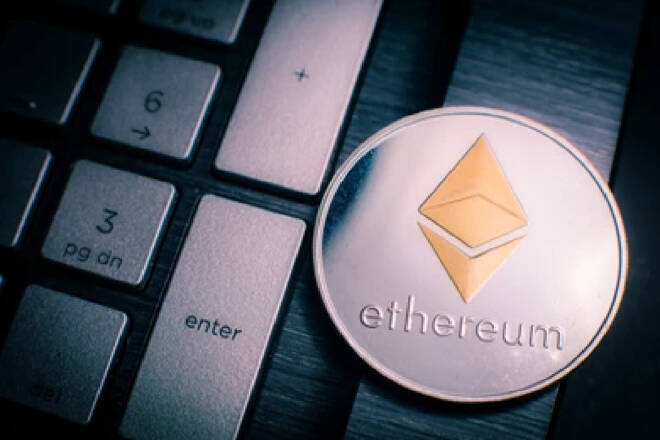Advertisement
Advertisement
ETH Eyes $1,800 on SEC Appeal Sentiment and Staking Statistics
By:
ETH found support this morning. However, staking statistics and the prospects of an SEC appeal will continue to test buyer appetite today.
In this article:
Key Insights:
- ETH joined the broader market in the red on Saturday, falling 1.37% to end the day at $1,866.
- Investor angst over SEC plans to appeal the SEC v Ripple ruling weighed.
- The shorter-term technical indicators remain bearish, signaling a fall to sub-$1,850.
Ethereum (ETH) fell by 1.37% on Saturday. Following a flat Friday session, ETH ended the day at $1,866. The bearish session left ETH at sub-$1,900 for the fifth consecutive session.
Ethereum Price Action
This morning, ETH was up 0.25% to $1,871. A range-bound start to the day saw ETH fall to an early low of $1,860 before rising to a high of $1,874.
Daily Chart
The Daily Chart showed ETH/USD sitting at the lower level of the $1,895 – $1,865 support band. Support at $1,850 limited the downside on Saturday.
However, ETH/USD also sits below the 50-day EMA ($1,873) while holding above the 200-day EMA ($1,776), sending bearish near-term but bullish longer-term price signals. Notably, the 50-day EMA narrowed on the 200-day EMA, affirming the bearish momentum.
Looking at the 14-Daily RSI, the 47.21 reading signaled a moderately bearish outlook, aligned with the 50-day EMA. Significantly, the RSI supports a fall to sub-$1,850 to bring the $1,815 – $1,795 support band into play. However, a move through the 50-day EMA ($1,873) would give the bulls a run at $1,950.
4-Hourly Chart
Looking at the 4-Hourly Chart, the ETH/USD faces strong resistance at $1,900. While ETH/USD sat at the lower level of the $1,895 – $1,865 support band, ETH remained below the 50-day ($1,899) and 200-day ($1,885) EMAs, sending bearish near and longer-term price signals.
Significantly, the 50-day EMA narrowed to the 200-day EMA, signaling a fall through the lower level of the $1,895 – $1,865 support band. A fall to sub-$1,850 would bring the $1,815 – $1,795 support band into view.
However, a move through the EMAs would give the bulls a run at $1,950.
The 14-4H RSI reading of 36.81 sends bearish ETH price signals, with selling pressure outweighing buying pressure. Significantly, the bearish RSI supports a fall through the lower level of the $1,895 – $1,865 support band to bring the $1,185 – $1,795 support band into view.
SEC Appeal Plans Test Buyer Appetite and Weigh on Staking Inflows
It was a quiet Saturday session, with no crypto events to move the dial. The lack of influence from the news wires left investors to digest the news of the SEC planning to appeal the SEC v Ripple Court ruling.
Earlier this year, SEC Chair Gary Gensler labeled ETH a security, exposing the second-largest coin by market cap to SEC regulation by enforcement. A successful SEC appeal could see the SEC ramp up its fight against the digital asset space. A lack of a regulatory framework would also be a bearish price scenario.
Notably, the news of the SEC planning to appeal also weighed on staking statistics. Staking inflows surged to 125,696 ETH as investors responded to the Court ruling. However, the threat of an appeal sent inflows back to pre-Court ruling levels.
Staking Statistics Send Bearish Price Signals
According to CryptoQuant, staking inflows fell from 80,384 ETH on Friday to 39,232 on Saturday. While staking inflows saw a marked decline, staking inflows were elevated compared to recent weekend trends.
The overnight withdrawal profile was neutral, with principal withdrawals at normal levels. However, withdrawal projections for the morning session are bearish. Projections show ETH withdrawals will sit at above-normal withdrawal levels throughout the morning.
On Saturday, the net ETH staking balance stood at a 76,770 ETH surplus ($145.14 million), down 21% over 24 hours. Deposits totaled 85,900 versus withdrawals of 9,120 ETH.
According to TokenUnlocks, total pending withdrawals stood at 31,660 ETH, equivalent to approximately $59.20 million. Notably, the staking APR stood at 5.77%, unchanged over 24 hours. The recent rise in the ETH staking APR and higher than-normal staking inflows are ETH price positive. However, the slide in the staking balance and the withdrawal profile are bearish price signals.
About the Author
Bob Masonauthor
With over 20 years of experience in the finance industry, Bob has been managing regional teams across Europe and Asia and focusing on analytics across both corporate and financial institutions. Currently he is covering developments relating to the financial markets, including currencies, commodities, alternative asset classes, and global equities.
Latest news and analysis
Advertisement
